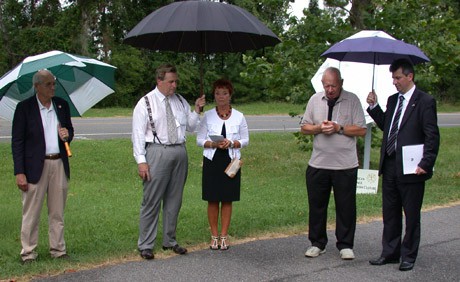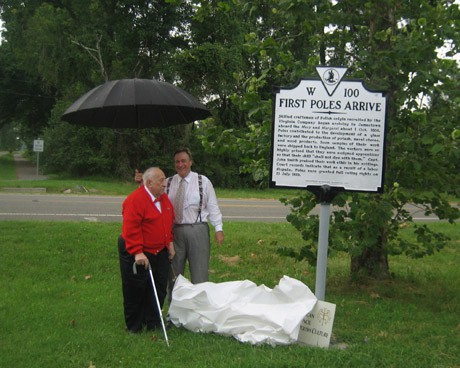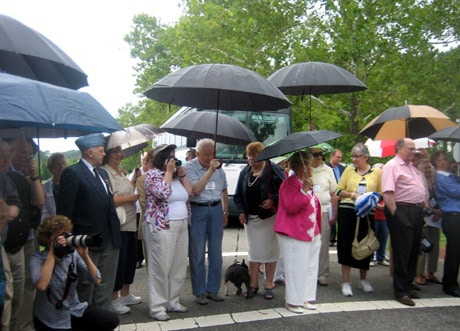
The historical marker
It was here, in the vicinity of historical markers devoted to German and African settlers of Jamestown and the Indian Princess Pocahontas, that a new marker has been placed, to record the arrival of Polish craftsmen at the site in 1608. These men came on the second supply ship, the “Mary and Margaret,” early in the history of the settlement when skilled hands and industrious individuals were needed to help the struggling English colony survive.
The dedication ceremonies began with Debbie Majka, President of the ACPC, welcoming the approximately 50 persons who assembled on the grassy area near the marker. At the same time a sporadic light summer shower started sprinkling the area, necessitating the use of umbrellas. After her greeting, Father Philip Majka (not related to Debbie) offered up a prayer.

(L. to R.) Mayor Claude Haulman, Thomas Payne, Debbie Majka, Fr. Philip Majka, and Consul Piotr Konowrocki
Then followed Mayor of Williamsburg Claude Haulman who underscored the importance of the occasion. Wendy Musumeci from the Commonwealth of Virginia Department of Historic Resources spoke about the importance of recognizing the contributions of immigrants in the Commonwealth. At one point her voice shook with emotion as she mentioned her Polish husband Martin and her baby son Maks, who were also present at the event.
Tom Payne, chairman of the Marker Committee, explained how the marker came about, and that because of the rich Polish-American history in Virginia, future markers were being contemplated. A definite possibility is one for Union General Vladimir “Kryz” Krzyzanowski who distinguished himself as a colonel in several Civil War battles while leading regiments composed of immigrant Germans and Poles. Yet, whose promotion was stalled because members of congress were unable to pronounce his excellent Polish name.
Colonel Lafayette Jones, US Army Retired, mentioned some of the vital roles that Poles played in the development of United States military history, singling out Tadeusz Kosciuszko — a military engineer and brigadier general in Washington’s army — who, among his several accomplishments during the Revolutionary War, prepared the defenses at Saratoga and laid plans for the fortifications at West Point, NY. This important bulwark, known as the Gibraltar of America, checked the British move south along the Hudson River and later became the site of America’s main military academy.
The commentaries were rounded out by Piotr Konowrocki, Consul General of the Polish Republic, who made the trip from Washington DC. His arrival was not announced earlier and it was a surprise to many of the organizers and spectators to see a car with diplomatic plates pull up to the site. He was most welcome however, as he brought greetings and good wishes from the Polish government and diplomatic corps on the occasion of this important event.
Then, Edward Pinkowski, 95 years old, one of Polonia’s most respected historians and a person who initiated the installation of several historical markers in Pennsylvania, was asked to come up. He pulled off the cover and as those present applauded, the marker was officially unveiled.

(L. to R.) Thomas Payne holds umbrella as Edward Pinkowski unveils marker
President Debbie Majka read aloud the words written in black letters on the silver surface of the marker: Skilled craftsmen of Polish origin recruited by the Virginia Company began arriving in Jamestown aboard the “Mary and Margaret” about 1 Oct. 1608. Poles contributed to the development of a glass factory and the production of potash, naval stores, and wood products. Soon samples of their work were shipped back to England. The workers were so highly prized that they were assigned apprentices so that their skill „shall not dye with them.” Capt. John Smith praised their work ethic in his writings. Court records indicate that as a result of a dispute, Poles were granted full voting rights on 21 July 1619.

The audience takes cover under umbrellas as a light summer shower begins to fall.
Fr. Thomas Machalski, Rector of the Polish Seminary at Orchard Lake Michigan delivered the closing prayer. Before returning to Williamsburg and continuing the annual convention of the ACPC many of the spectators stayed around to admire this latest addition to the set of historical markers, and had their pictures taken on site. These and additional photographs of the ceremonies may be seen at www.poles.org. Information about the American Council for Polish Culture is on: www.PolishCultureACPC.org.
Photographs: Jacqueline „Jadzia” Kolowski
